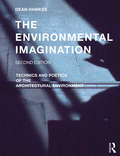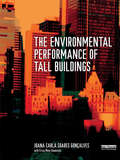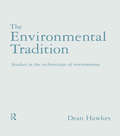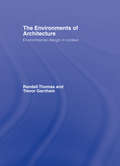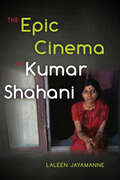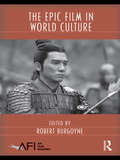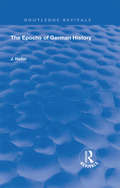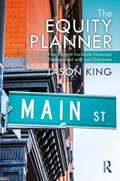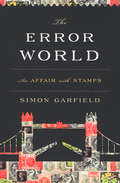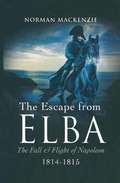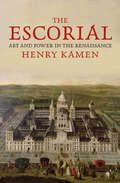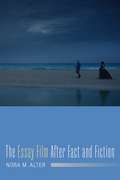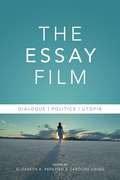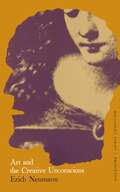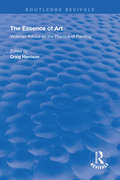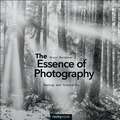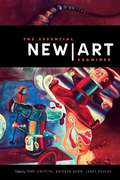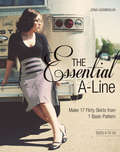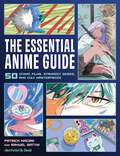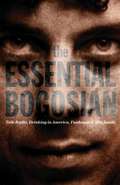- Table View
- List View
The Environmental Imaginary In Brazilian Poetry And Art
by Malcolm K. McneeThis study contributes to ongoing discussions on the connections between the environmental imaginary and issues of identity, place and nation. Utilizing a delimited ecocritical approach, McNee puts Brazilian culture, through the work of contemporary poets and visual artists, into a broader, transnational dialogue.
The Environmental Imagination: Technics and Poetics of the Architectural Environment
by Dean HawkesThe Environmental Imagination explores the relationship between tectonics and poetics in environmental design in architecture. Working thematically and chronologically from the eighteenth century to the present day, this book redefines the historiography of environmental design by looking beyond conventional histories to argue that the environments within buildings are a collaboration between poetic intentions and technical means. In a sequence of essays, the book traces a line through works by leading architects of the nineteenth and twentieth centuries that illustrate the impact of new technologies on the conception and realisation of environments in buildings. In this, a consideration of the qualitative dimension of environment is added to the primarily technological narratives of other accounts. In this second edition, the book has been substantially rewritten and restructured to include further research conducted in the decade since the first edition. A number of important buildings have been revisited, in order to extend the descriptions of their environments, and studies have been made of a number of newly studied, significant buildings. A completely new essay offers an environmental interpretation of Luis Barragán’s magical own house in Mexico City and the earlier studies of buildings by Peter Zumthor have been gathered into a single, extended essay that includes a body of new research. On the fiftieth anniversary of the publication of Reyner Banham’s, The Architecture of the Well-tempered Environment, the book concludes with a critical tribute to that seminal text. The Environmental Imagination will appeal to academics and practitioners with interests in the history, theory and technology of architecture.
The Environmental Performance of Tall Buildings
by Joana Carla GoncalvesTall buildings represent one of the most energy-intensive architectural typologies, while at the same time offering the high density work and living conditions that many believe will an important constituent of future sustainable communities. How, then, can their environmental impact be lessened? This insightful book takes in: an overview of the tall building and its impacts (looking at cityscape, place, mobility, microclimate, energy and economics) design principles and the development of the sustainable tall building global perspectives (covering North and South America, Europe, the Middle East and Asia) detailed, qualitative case studies of buildings in design and operation the future for sustainable tall buildings. Not simply another showcase for future utopian designs and ideals, the information presented here is based on hard research from operating buildings. Highly illustrated and combining analysis with solid detail for practice, this is essential reading for architects, building engineers, design consultants, retrofitters and urban planners interested in or working with tall buildings, and researchers/students in these disciplines.
The Environmental Tradition: Studies in the architecture of environment
by Dean Hawkes Dr Dean HawkesThis text brings together a unique collection of writing by a leading researcher and critic which outlines the evolution of the environmental dimension of architectural theory and practice in the past twenty-five years. It deals with the transformation of the environmental design field which was brought about by the growth of energy awareness in the 1970s and 1980s, and places environmental issues in the broader theoretical and historical context in architecture.
The Environments of Architecture: Environmental Design in Context
by Randall Thomas Trevor GarnhamThis well-illustrated 'think piece' provides a much needed and topical philosophical introduction to the place of environmental design in architecture. The Environments of Architecture sets out a range of considerations necessary to produce appropriate internal environments in the context of a wider discussion on the effect of building decisions on the broader environment. The authors, from architecture and engineering, academia and practice, provide a rounded and well-balanced introduction to this important topic. Starting from a belief that the built environment can contribute more positively to the planet and the pleasure of places as well as answering the practical demands of comfort, they cover site planning, form, materials, construction and operation as well as looking at design on a city level. Presenting a thoughtful and stimulating approach to the built environment, this book forms an excellent guide for practitioners, students and academics concerned with our built environment.
The Epic Cinema of Kumar Shahani
by Laleen JayamanneThe Epic Cinema of Kumar Shahani examines the major works of leading Indian film director Kumar Shahani and explores the reaches of modernist film aesthetics in its international form. More than an auteur study, Laleen Jayamanne approaches Shahani's oeuvre conceptually, as films that reveal cinema's synesthetic capabilities. As the author illustrates, Shahani's cinematic project entails a modern reformulation of the ancient oral tradition of epic narration and performance in order to address the contemporary world, establishing a new cinematic expression. As evidenced by his films, constructing cinematic history entails more than an archival project of retrieval and is a living history of the present, which can intervene in the current moment through sensory experiences.
The Epic Film in World Culture (AFI Film Readers)
by Robert BurgoyneWith the recent release of spectacular blockbuster films from Gladiator to The Lord of the Rings trilogy, the epic has once again become a major form in contemporary cinema. This new volume in the AFI Film Readers series explores the rebirth of the epic film genre in the contemporary period, a period marked by heightened and conflicting appeals to national, ethnic, and religious belonging.The orginal essays in this volume explore the tension between the evolving global context of film production and reception and the particular provenance of the epic as an expression of national mythology and aspirations, challenging our understanding of epics produced in the present as well as our perception of epic films from the past. The contributors will explore new critical approaches to contemporary as well as older epic films, drawing on ideas from cultural studies, historiography, classics, and film studies.
The Epic Film: Myth and History (Routledge Library Editions: Cinema)
by Derek ElleyAs Charlton Heston put it: ‘There’s a temptingly simple definition of the epic film: it’s the easiest kind of picture to make badly.’ This book goes beyond that definition to show how the film epic has taken up one of the most ancient art-forms and propelled it into the modern world, covered in twentieth-century ambitions, anxieties, hopes and fantasies. This survey of historical epic films dealing with periods up to the end of the Dark Ages looks at epic form and discusses the films by historical period, showing how the cinema reworks history for the changing needs of its audience, much as the ancient mythographers did. The form’s main aim has always been to entertain, and Derek Elley reminds us of the glee with which many epic films have worn their label, and of the sheer fun of the genre. He shows the many levels on which these films can work, from the most popular to the specialist, each providing a considerable source of enjoyment. For instance, spectacle, the genre’s most characteristic trademark, is merely the cinema’s own transformation of the literary epic’s taste for the grandiose. Dramatically it can serve many purposes: as a resolution of personal tensions (the chariot race in Ben-Hur), of monotheism vs idolatry (Solomon and Sheba), or of the triumph of a religious code (The Ten Commandments). Although to many people Epic equals Hollywood, throughout the book Elley stresses debt to the Italian epics, which often explored areas of history with which Hollywood could never have found sympathy. Originally published 1984.
The Epochs of German History (Routledge Revivals #18)
by J. HallerOriginally published in 1930. This book is not intended to be a discussion on German history, but to talk about its epochs, a period in which some fresh beginning is made, some fresh determining element enters, some event occurs to give a new direction to the course of history. The book is concerned with the critical moments of German history, the turning points in its course. Those are what we want to consider, wnd also to select as points of vantage from which we may survey the development of the German nation, viewing the panorama section by section.
The Equity Planner: Five Tools to Facilitate Economic Development with Just Outcomes
by Jason KingEconomic development is intended to benefit everyone in a community; however, in many cases, increased public and private investment can result in the pricing out and displacement of existing residents and businesses. How do we achieve more equitable outcomes? The Equity Planner provides a toolkit of practical solutions for planners and all those involved in placemaking to promote thoughtful, inclusive planning. Each chapter of The Equity Planner examines one particular aspect of inequity in the urban planning sphere, covering issues such as identity retention, affordability, and the protection and enhancement of local assets. While each chapter offers practicable solutions to these issues, the "Notes from the Field" sections describe how these same tools have been used (either successfully or unsuccessfully) in projects the author has been involved in, with a particular focus on the local resistance each project encountered. These real-world case studies are used to suggest methods to overcome such resistance, which the reader can then apply to their present initiatives. This book is written for urban planners, local activists, social scientists, policymakers, and anyone with an interest in equity planning. This book will be of use to both practicing and training urban planners and architects who seek to add equity planning to their professional repertoire.
The Eroticizing of HIV: Viral Fantasies (Health, Technology and Society)
by Jaime García-IglesiasThis book examines sexual fantasies and their influence on everyday life through the stories of twenty-two men who introduce themselves as bugchasers, i.e. gay men who eroticize HIV. The author defines bugchasing, charts its history and contexts, and considers how it has changed in the age of internet and PrEP. Through the participants, their experiences and contexts, this text also theorizes about sexual fantasies, seeking to understand how people define sexual fantasies and use the internet as a space to navigate their desires, meet others, and find support. Chapters also consider the practical implications of fantasy, most notably, how fantasies influence men’s decisions around HIV prevention and care. This book speaks to renewed interest in both the AIDS crisis and the sociology of everyday life to illustrate how fantasies such as bugchasing appear, evolve, and adapt. This book will be of interest to scholars focused on queer studies, sexuality studies, gender studies, and healthcare.
The Error World: An Affair with Stamps
by Simon GarfieldAn obsessively readable memoir about the passions—and perils—of collecting, from the New York Times–bestselling author of Just My Type. From the Penny Red to the Blue Mauritius, generations of collectors have been drawn to the mystique of rare stamps. Once a widespread pastime of schoolboys, philately has increasingly become the province of older men obsessed with the shrewd investment, the once-in-a-lifetime find, the one elusive beauty that will complete a collection and satisfy an unquenchable thirst. As a boy, Simon Garfield collected errors—rare pigment misprints that create ghostly absences in certain stamps. Then, in his mid-forties, this passion reignited—and it began to consume him. In the span of a couple of years, he amassed a collection of errors worth upwards of forty thousand British pounds. But as he was pursuing this secret passion, he was also pursuing a romantic one—while his marriage disintegrated. In this unique memoir, Simon Garfield twines the story of his philatelic obsession with an honest, engrossing exploration of the rarities and absences that both limit and define us. The end result is a thoughtful, funny, and enticing meditation on the impulse to possess.
The Escape from Elba: The Fall & Flight of Napoleon, 1814–1815
by Norman MacKenzieThe year is 1814. The Allies have driven Napoleon's once-mighty armies back to Paris. Trapped, forced to abdicate after two decades of triumphant rule, the Emperor takes leave of his comrades-in-arms and sets sail for his new domain - the tiny, poverty-stricken, pestilential island of Elba. Yet within ten months Napoleon will enter Paris once again, at the heels of the fleeing Bourbon king, flushed with victory and cheered by the masses. The Escape From Elba tells the heroic story of Napoleon's exile and phoenix-like return. In this classic account, now republished in paperback, Norman MacKenzie chronicles this extraordinary year: the tense last hours of Napoleon's empire, his humiliating exile, his midnight escape and his whirlwind march over snowbound mountains to Grenoble where, in a dramatic confrontation with the French army, he became a reigning prince again. Described in vivid detail are Napoleon's adventures as the head of Elba. He brought society, splendour, organization and political intrigue to this run-down backwater. And he displayed on this small stage the many sides of his charismatic.
The Escorial
by Henry KamenFew buildings have played so central a role in Spain's history as the monastery-palace of San Lorenzo del Escorial. Colossal in size and imposing--even forbidding--in appearance, the Escorial has invited and defied description for four centuries. Part palace, part monastery, part mausoleum, it has also served as a shrine, a school, a repository for thousands of relics, and one of the greatest libraries of its time. Constructed over the course of more than twenty years, the Escorial challenged and provoked, becoming for some a symbol of superstition and oppression, for others a "wonder of the world. " Now a World Heritage Site, it is visited by thousands of travelers every year. In this intriguing study, Henry Kamen looks at the circumstances that brought the young Philip II to commission construction of the Escorial in 1563. He explores Philip's motivation, the influence of his travels, the meaning of the design, and its place in Spanish culture. It represents a highly engaging narrative of the high point of Spanish imperial dominance, in which contemporary preoccupations with art, religion, and power are analyzed in the context of this remarkable building.
The Essay Film After Fact and Fiction (Film and Culture Series)
by Nora M. AlterNora M. Alter reveals the essay film to be a hybrid genre that fuses the categories of feature, art, and documentary film. Like its literary predecessor, the essay film draws on a variety of forms and approaches; in the process, it fundamentally alters the shape of cinema. The Essay Film After Fact and Fiction locates the genre’s origins in early silent cinema and follows its transformation with the advent of sound, its legitimation in the postwar period, and its multifaceted development at the turn of the millennium. In addition to exploring the broader history of the essay film, Alter addresses the innovative ways contemporary artists such as Martha Rosler, Isaac Julien, Harun Farocki, John Akomfrah, and Hito Steyerl have taken up the essay film in their work.
The Essay Film: Dialogue, Politics, Utopia
by Caroline Eades Elizabeth PapazianWith its increasing presence in a continuously evolving media environment, the essay film as a visual form raises new questions about the construction of the subject, its relationship to the world, and the aesthetic possibilities of cinema. In this volume, authors specializing in various national cinemas (Cuban, French, German, Israeli, Italian, Lebanese, Polish, Russian, American) and critical approaches (historical, aesthetic, postcolonial, feminist, philosophical) explore the essay film and its consequences for the theory of cinema while building on and challenging existing theories. Taking as a guiding principle the essay form's dialogic, fluid nature, the volume examines the potential of the essayistic to question, investigate, and reflect on all forms of cinema-fiction film, popular cinema, and documentary, video installation, and digital essay.A wide range of filmmakers are covered, from Dziga Vertov (Man with a Movie Camera, 1928), Chris Marker (Description of a Struggle, 1960), Nicolás Guillén Landrián (Coffea Arábiga, 1968), Pier Paolo Pasolini (Notes for an African Oresteia, 1969), Chantal Akerman (News from Home, 1976) and Jean-Luc Godard (Notre musique, 2004) to Nanni Moretti (Palombella Rossa, 1989), Mohammed Soueid (Civil War, 2002), Claire Denis (L'Intrus, 2004) and Terrence Malick (The Tree of Life, 2011), among others. The volume argues that the essayistic in film-as process, as experience, as experiment-opens the road to key issues faced by the individual in relation to the collective, but can also lead to its own subversion, as a form of dialectical thought that gravitates towards crisis.
The Essay Film: Dialogue, Politics, Utopia (Nonfictions)
by Elizabeth Caroline Eades PapazianWith its increasing presence in a continuously evolving media environment, the essay film as a visual form raises new questions about the construction of the subject, its relationship to the world, and the aesthetic possibilities of cinema. In this volume, authors specializing in various national cinemas (Cuban, French, German, Israeli, Italian, Lebanese, Polish, Russian, American) and critical approaches (historical, aesthetic, postcolonial, feminist, philosophical) explore the essay film and its consequences for the theory of cinema while building on and challenging existing theories. Taking as a guiding principle the essay form's dialogic, fluid nature, the volume examines the potential of the essayistic to question, investigate, and reflect on all forms of cinema—fiction film, popular cinema, and documentary, video installation, and digital essay.A wide range of filmmakers are covered, from Dziga Vertov (Man with a Movie Camera, 1928), Chris Marker (Description of a Struggle, 1960), Nicolás Guillén Landrián (Coffea Arábiga, 1968), Pier Paolo Pasolini (Notes for an African Oresteia, 1969), Chantal Akerman (News from Home, 1976) and Jean-Luc Godard (Notre musique, 2004) to Nanni Moretti (Palombella Rossa, 1989), Mohammed Soueid (Civil War, 2002), Claire Denis (L'Intrus, 2004) and Terrence Malick (The Tree of Life, 2011), among others. The volume argues that the essayistic in film—as process, as experience, as experiment—opens the road to key issues faced by the individual in relation to the collective, but can also lead to its own subversion, as a form of dialectical thought that gravitates towards crisis.
The Essays of Erich Neumann, Volume 1: Art and the Creative Unconscious (Works by Erich Neumann #23)
by Erich NeumannFour essays on the psychological aspects of art. A study of Leonardo treats the work of art, and art itself, not as ends in themselves, but rather as instruments of the artist's inner situation. Two other essays discuss the relation of art to its epoch and specifically the relation of modern art to our own time. An essay on Chagall views this artist in the context of the problems explored in the other studies.
The Essence of Art: Victorian Advice on the Practice of Painting (Routledge Revivals)
by Craig HarrisonFirst published in 1999, this book asks what kind of advice was available to somebody wishing to embark upon oil painting in England between 1850 and 1900. It is a fascinating collection of Victorian instruction on how and what to paint, linked to crucial advice about art, its meaning and its relation to contemporary life, given by practising artists, important and often popular in their time, but whose lectures and writings are long overdue for reappraisal: Leslie, Hamerton, O’Neil, Poynter, Watts, Leighton, Armitage, Quilter and Herkomer. Here, beyond the familiar voices of Ruskin, Whistler and Pater, we have a whole range of experience from an age in which issues about painting were hotly debated by large numbers of people: professional artists, amateurs, critics, gallery-goers and Academy students. This anthology brings back to life the humour, seriousness, ambitions, eccentricities and controversies of people whose work shaped the nature of mainstream Victorian art.
The Essence of Photography
by Bruce BarnbaumThere is a lot more to photography than simply picking up a camera, pointing it toward something, and tripping the shutter. Achieving a great photograph requires thought and preparation, an understanding of the photographic process, and a firm grasp of how light and composition affect a photo. There must be personal involvement and personal expression. There must be experimentation, with the recognition that only a small percentage of experiments end successfully.In this book, best-selling author and world-renowned photographer and teacher Bruce Barnbaum explores these seldom-discussed issues by drawing upon his personal experiences and observations from more than 40 years of photographing and teaching. In addition to photographs, Bruce also uses painting, music, and writing, as well as the sciences and even business, to provide pertinent examples of creative thinking. These examples serve as stepping-stones that will lead you to your own heightened ability to see and be creative.Creativity is a topic that is almost wholly ignored in formal education because most instructors think that it cannot be taught or learned. To the contrary, Bruce has proven that photographic seeing and creativity can be taught, learned, and improved. This book expands on the ideas that are central to Bruce's method of teaching photography, which he has used in workshops for the past 41 years.Included in the book are in-depth discussions on the following topics:Defining your own unique rhythm and approach as a photographerHow to translate the scene in front of you to the final photographThe differences and similarities between how an amateur and a professional approach photographyThe differences between realism and abstraction, and the possibilities and limitations of eachLearning to expand your own seeing and creativity through classes, workshops, and associating with other photographersWhy the rules of composition should be ignoredHow to follow your passionWhen to listen to the critics and when to ignore themThe book is richly illustrated with over 90 photographs taken by Bruce as well as other photographers.Seeing and creativity are difficult to teach, but not impossible. This very different, perhaps groundbreaking book is sure to inspire photographers of all skill levels-from beginners to seasoned professionals-to think deeply about the issues involved in creating successful photographs.
The Essence of Provence: The Story of L'Occitane
by Pierre Magnan Richard SeaverThe extraordinary rags-to-riches tale of Olivier Baussan and the roadside soap stand that became L'Occitane, one of the world's most successful purveyors of natural fragrances. Founded in 1976 by Olivier Baussan, the now world-renowned fragrance company L'Occitane, "a woman of Provence" in Old French, was inspired by the essences of lavender and honeysuckle, rosemary, sage, and thyme indigenous to his childhood home in the south of France. In fact, it had been since the mid-1950s that Provence had been working its magic on the Baussan family, who left their urban life for a farm in Ganagobie when their son Olivier was only six months old.Blessed with a wonderfully acute sense of smell, Olivier eventually grew up to realize that he'd been born to distill and disseminate the many and varied perfumes of the region. His epiphany came when, at twenty-two, he found an abandoned still on the side of the road and bought it for a song. Using the countryside's natural ingredients, he began manufacturing shampoos, colognes, bath essences, and soaps. Starting with five employees-including Olivier's wife and mother-in-law-his fledgling company grew into a major business. Today, with hundreds of stores and thousands of employees worldwide, L'Occitane ranks as one of the world's most successful businesses-encapsulating a bit of paradise.
The Essential "New Art Examiner"
by Janet Koplos Terri Griffith Kathryn BornThe New Art Examiner was the only successful art magazine ever to come out of Chicago. It had nearly a three-decade long run, and since its founding in 1974 by Jane Addams Allen and Derek Guthrie, no art periodical published in the Windy City has lasted longer or has achieved the critical mass of readers and admirers that it did. The Essential New Art Examiner gathers the most memorable and celebrated articles from this seminal publication. First a newspaper, then a magazine, the New Art Examiner succeeded unlike no other periodical of its time. Before the word "blog" was ever spoken, it was the source of news and information for Chicago-area artists. And as its reputation grew, the New Art Examiner gained a national audience and exercised influence far beyond the Midwest. As one critic put it, "it fought beyond its weight class." The articles in The Essential New Art Examiner are organized chronologically. Each section of the book begins with a new essay by the original editor of the pieces therein that reconsiders the era and larger issues at play in the art world when they were first published. The result is a fascinating portrait of the individuals who ran the New Art Examiner and an inside look at the artistic trends and aesthetic agendas that guided it. Derek Guthrie and Jane Addams Allen, for instance, had their own renegade style. James Yood never shied away from a good fight. And Ann Wiens was heralded for embracing technologies and design. The story of the New Art Examiner is the story of a constantly evolving publication, shaped by talented editors and the times in which it was printed. Now, more than three decades after the journal's founding, The Essential New Art Examiner brings together the best examples of this groundbreaking publication: great editing, great writing, a feisty staff who changed and adapted as circumstances dictated—a publication that rolled with the times and the art of the times. With passion, insight, and editorial brilliance, the staff of the New Art Examiner turned a local magazine into a national institution.
The Essential A-Line: Make 17 Flirty Skirts from 1 Basic Pattern
by Jona GiammalvaThe expert seamstress behind Make Sewing Studio shows you how to sew your own wardrobe of A-line skirts—all from 1 easy pattern! In The Essential A-line, you&’ll learn how to whip up a chic skirt in no time. Seamstress Jona Giammalva demonstrates how simple variations on a single pattern can make 17 stylish skirts in a range of sizes from 0–2x. Her beginner-friendly, step-by-step instructions and informative color photographs will guide and inspire sewers of any skill level. Along with getting a collection of great skirts, you'll also learn essential dressmaking techniques—from inserting a zipper to mastering the perfect pleat.
The Essential Anime Guide: 50 Iconic Films, Standout Series, and Cult Masterpieces
by Patrick Macias Samuel SattinFeaturing 50 of the most influential and essential Japanese animated series and films—from Akira to Cowboy Bebop to Sailor Moon—this expert guide is the must-have book for anime fans young and old. The Essential Anime Guide is the guide every fan needs to the classic, must-see anime series and films that transformed both Japanese and Western pop culture. Organized by release date and with entries by experts in the anime field, this guide provides a comprehensive, behind-the-scenes look into the history and impact of these classic anime. Both casual fans and serious otaku alike will discover a fun and surprisingly touching portrait of the true impact of anime on pop culture. Ranging from classic series to modern films, this official guide will explore iconic and must-see: Feature films: Akira (1988), Princess Mononoke (1997), Millennium Actress (2001), Metropolis (2001),Tekkonkinkreet (2006), Sword of the Stranger (2007), Summer Wars (2009), and Your Name (2016) Series: Astro Boy (1968), Lupin the 3rd (1967), Macross (1982), Ranma 1/2 (1989), Neon Genesis Evangelion (1995), Dragon Ball Z (1989), Sailor Moon (1992), Revolutionary Girl Utena (1997), Pokémon (1997), One Piece (1999), Fullmetal Alchemist (2003), K-On! (2007), Sword Art Online (2012), Yuri!! On Ice (2016), and My Hero Academia (2018) And many more!
The Essential Bogosian
by Eric Bogosian"What Lenny Bruce was to the 1950s, Bob Dylan to the 1960s, Woody Allen to the 1970s--that's what Eric Bogosian is to this frightening moment of drift in our history."--Frank Rich, The New York Times

